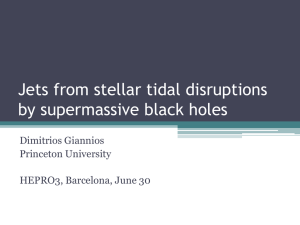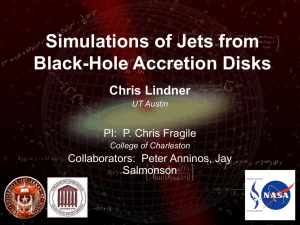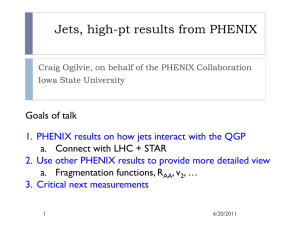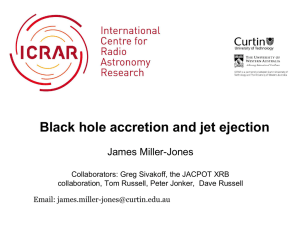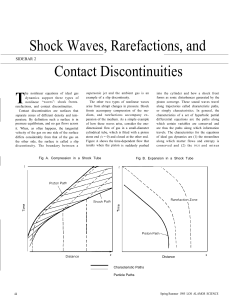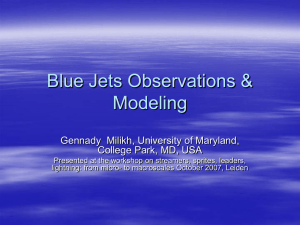Komissarov - Purdue University
advertisement
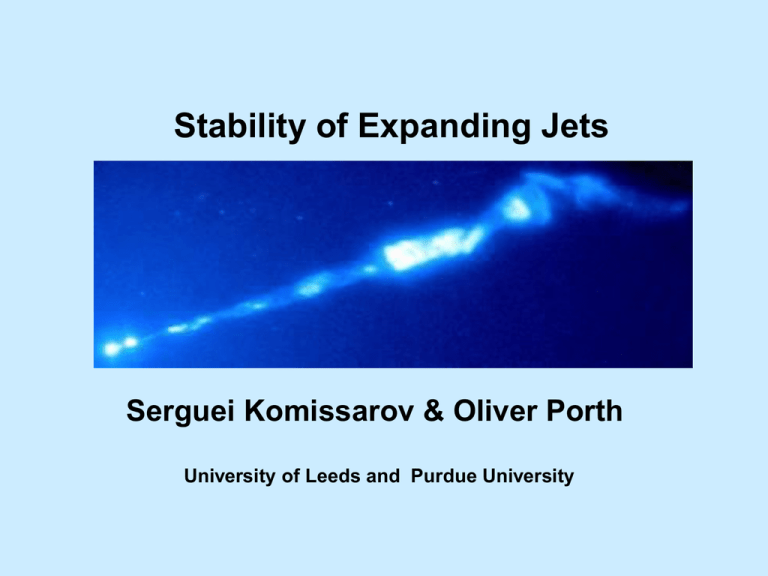
Stability of Expanding Jets Serguei Komissarov & Oliver Porth University of Leeds and Purdue University Introduction • • • AGN jets are remarkably stable compared to their terrestrial counterparts. They propagate over distances up to one billion(!) of initial jet radius; They exhibit substantial radial expansion. The radius of M87 jet increases by ~ one million times. Expansion is know to have a stabilising effect (e.g. Moll et al. 2008); They propagate through atmospheres with rapidly decreasing pressure (and density). We are out to check that: These are related. The stability is due to the loss of connectivity, caused by the rapid decline of external pressure. Stability and Causality Only global instabilities can threaten the jet survival. For a global instability to develop, the jet has to be causally connected in the transverse direction. The condition is µM > µj µM - Mach angle (for the fastest wave), µj = Rj =r - jet opening angle. µM µj r Rj Stability and Causality Jets confined by external pressure, pex t / r ¡ · : • Hot jets: µM =µj / r 1¡ · =2 The jet expands freely – not causally connected – when · > 2 • Poynting-dominated relativistic jets: The same conclusion! (Komissarov at al.,2009, Lyubarsky 2009) · = 2 is a critical value. Stability and Causality · ' 2 is a typical value for AGN. ( Begelman et al. 1984 ) Inner Edge of Radiation-Supported Accretion Disk: r ' 1014 cm pex t ' 107 dyn cm¡ 2 Radio Lobes: r ' 1023cm pex t ' 10¡ · ' 2 11 dyn cm¡ 2 In coronas of ellipticals ( 100pc – 10kpc ), · ' 1:2 : Expect · > 2 closer to the core -> free expansion. Steady-State Jets via 1D simulations One can use 1D time-dependent simulations to construct approximate 2D steady-state solutions. Example. 2D steady-state continuity equation: @½¡ v1 @½¡ v2 + = 0: 1 2 @x @x Suppose v1 ' c . Replace v1 with c and x1 with ct to obtain @½¡ @½¡ v2 + ' 0 2 @t @x - 1D time-dependent continuity eq. Boundary conditions: Replace V = Vex t (x 1 ) at the 2D jet boundary with V = Vex t (ct) at the 1D “jet” boundary. Steady-State Jets via 1D simulations Test model: Axisymmetric Relativistic MHD jets The initial solution describes a 1D cylindrical jet in magnetostatic equilibrium (Komissarov 1999); purely azimuthal magnetic field. bf / r G / 1=r p s Kink-unstable in uniform external medium O’Neil et al.(2012) Steady-State Jets via 1D simulations Test model: Axisymmetric Relativistic MHD jets Rj ;0 = 1:0; k= 0.5 ¡ j ;0 ' 3; k =1.0 ¾j ;0 ' 0:2; k=1.5 pex t ; ½ex t / t ¡ k=2.0 · : Expanding 3D Jets in a Periodic Box The approach: Introduce time-dependent external pressure, pex t / t ¡ · ; to study the role of expansion on stability of jets using the periodic box setup. To allow perturbations of the external gas we use the forcing approach: dpex t (pex t ¡ p^ex t (t)) = ¡ ; dt tr p^ex t (t) / t ¡ · ; Rj et tr = ¹ : c The same approach is used to control other parameters of the external gas. The value of m is such that for k=0 the results are not strongly influenced by the forcing, which inhibits wave emitted by the jet. Expanding 3D Jets in a Periodic Box Perturbation (kinks): vr (r; Á; z) = (¢ v=N ) exp(¡ r =r m ) XN cosÁsin(2¼nz=L z ) n= 1 N = 4; ¢ vr = 0:01; z - distance along the jet, Lz – box size (Mizuno et al., 2011) Constant external pressure, k=0 . The jet is destroyed over the distance ~ 100 initial radii (c=1) Expanding jet, k=1.0 The jet propagates at least ten times further (1000 initial radii; end of simulations) It develops irregular “knotty” structure Jet energetics; 3D versus 1D (steady-state) At r < 500 Rj,0 , the 3D solution follows closely the steady-state one. At r > 500 Rj,0 (the highly-nonlinear phase), wave losses and magnetic dissipation in the 3D model. Preliminary conclusions • Rapid decline of external pressure is the main factor behind the observed stability of astrophysical jets; • Jets are expected to flare when entering flat sections of external atmospheres. Instability -> Dissipation -> Emission. Bulk acceleration is another likely outcome for highly magnetized relativistic jets. Preliminary conclusions • This is still “work in progress”; • Rapid decline of external pressure is identified as the main factor behind the observed stability of astrophysical jets; • Jets are expected to flare when entering flat sections of external atmospheres. Instability -> Dissipation -> Emission. Bulk acceleration is another likely outcome for highly magnetized relativistic jets. The End
